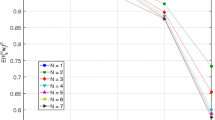Abstract
In this paper, we are concerned with a multiuser downlink massive MIMO system operating over Ricean fading channels where each user can be equipped with one or multiple antennas. We present a beamforming (BF) transmission scheme that is only based on the specular component, which can reduce efficiently the heavy overhead for channel estimation. For the individual achievable rates, we particularly analyze their power-scaling law when the transmit power per user is scaled down by the number of antennas at the base station (BS). It is found that the individual rates of the proposed BF can be higher than the corresponding rates of the BF based on the scattered and specular components if the specular component is relatively strong. In addition, it is shown that each user can asymptotically achieve the same rate as in the single-user case when both the numbers of BS antennas and the user terminals go to infinity with a fixed ratio. Thus we conclude that the massive MIMO systems may be more suitable to be deployed in Ricean fading rather than Rayleigh fading.



Similar content being viewed by others
References
Marzetta, T. L. (2010). Noncooperative cellular wireless with unlimited numbers of base station antennas. IEEE Transactions on Wireless Communications, 9(11), 3590–3600.
Marzetta, T. L. (2015). Massive MIMO: An introduction. Bell Labs Technical Journal, 20, 11–22.
Bjõrnson, E., Larson, E. G., & Marzetta, T. L. (2016). Massive MIMO: Ten myths and one critical question. IEEE Communications Magazine, 54(2), 114–123.
Lu, L., Li, G. Y., Swindlehurst, A. L., Ashikhmin, A., & Zhang, R. (2014). An overview of massive MIMO: Benefits and challenges. IEEE Journal of Selected Topics in Signal Processing, 62(5), 742–758.
Yang, H., & Marzetta, T. L. (2013). Performance of conjugate and zero-forcing beamforming in large-scale antenna systems. IEEE Journal on Selected Areas in Communications, 31(2), 172–179.
Ngo, H. Q., Larsson, E. G., & Marzetta, T. L. (2013). Energy and spectral efficiency of very large multiuser MIMO systems. IEEE Transactions on Communications, 61(4), 1436–1449.
Zhang, Q., Jin, S., Wong, K.-K., Zhu, H., & Mattaiou, M. (2014). Power scaling of uplink massive MIMO systems with arbitrary-rank channel means. IEEE Journal of Selected Topics in Signal Processing, 62(5), 966–981.
Elijah, O., Leow, C. Y., & Rahman, T. A. (2016). A comprehensive surevey of pilot contamination in massive MIMO—5G system. IEEE Communications Surveys & Tutorials, 18(2), 905–923.
Yue, D.-W., Zhang, Y., & Jia, Y.-N. (2015). Beamforming based on specular component for massive MIMO systems in Rician fading. IEEE Wireless Communications Letters, 4(2), 197–200.
Yue, D.-W. (2016). Specular component-based beamforming for broadband massive MIMO systems with doubly-ended correlation. IET Electronics Letters, 52(12), 1082–1084.
Lim, Y.-G., Chae, C.-B., & Caire, G. (2015). Performance analysis of massive MIMO for cell-boundary users. IEEE Transactions on Wireless Communications, 14(12), 6827–6842.
Ngo, H. Q., Matthaiou, M., & Larsson, E. G. (2014). Massive MIMO with optimal power and training duration allocation. IEEE Wireless Communications Letters, 3(6), 605–608.
Dabbagh, A. D., & Love, D. J. (2008). Multiple antenna MMSE based downlink precoding with quantized feedback or channel mismatch. IEEE Transactions on Communications, 56(11), 1859–1868.
Mitrinović, D. S. (1970). Analytic inequalities. Berlin: Springer.
Acknowledgements
This work was supported in part by the Specialized Research Fund for the Doctoral Program of Higher Education under Grant 20132125110006, and the open research fund of Zhejiang Provincial Key Lab of Data Storage and Transmission Technology, Hangzhou Dianzi University, under Grant 201401.
Author information
Authors and Affiliations
Corresponding author
Appendix
Appendix
1.1 Proof of Theorem 1
Proof
By using Jensen’s Inequality, we obtain the following lower bound on the ergodic achievable rate of the k-th user
Now define \(\bar{\gamma }_k^{\mathtt {L}}(K)=\frac{1}{\mathbb {E}(1/ \gamma _k(K))}\). Then from (10) it follows that
Since each entry \(\tilde{h}_{nm}^{(k)}\) in \(\widetilde{\mathbf {H}}_k\) follows \(\text{ CN }(0,1)\), and all of them are i.i.d, we can have from the knowledge of statistics that
Furthermore, we can obtain the following expression
In addition, we also have that
where \(\varphi _{ki}=2\pi d (\sin (\phi _k)-\sin (\phi _i))\). If let \(\varrho _{ki}=\frac{1-e^{jM\varphi _{ki}}}{1-e^{j\varphi _{ki}}}\), then
Finally, (12) can be easily derived with the help of the following expression
On the other hand, from (10) it is obvious that
Now define \(\bar{\gamma }_k^{\mathtt {U}}(K)=\frac{p_b\beta _k\bar{\vartheta }_k}{K}MN\). Then (13) holds.
1.2 Proof of Corollaries 1 and 2
Under the condition given in Corollary 1 or Corollary 2, we only need to prove that (12) can tend to (13) as \(M \rightarrow \infty\). (12) can be rewritten as
Due to the fact that \(\frac{K}{M N} \rightarrow 0\), now we only need to prove that
When K is finite, it is obvious that (30) holds since \(|\varrho _{ki}|^2 \le \frac{4}{|1-e^{j\varphi _{ki}}|^2}\) is still finite as M grows large. Thus Corollary 1 holds. For infinite K, we define \(\mathbb {E}|\varrho _{ki}|^2=\omega _k\). According to the law of large numbers, we know that
Furthermore, under the given condition of Corollary 2, we have that (30) holds and thus Corollary 2 holds.
1.3 Proof of Theorem 2
Suppose that \(N=1\). From Corollary 1 it follows that
On the other hand, by following a similar line of reasoning as in [7], we can obtain
Based on Bernoulli’s Inequality in [14] and the given condition \(\vartheta _k\ge \frac{T-\tau }{\tau }\sigma ^2_k\), we further have
So we finally arrive at the desired result in (20).
Rights and permissions
About this article
Cite this article
Yue, DW., Yan, Q. Beamforming Only Based on Specular Component for Downlink Massive MIMO Systems. Wireless Pers Commun 95, 1799–1810 (2017). https://doi.org/10.1007/s11277-016-3919-z
Published:
Issue Date:
DOI: https://doi.org/10.1007/s11277-016-3919-z




